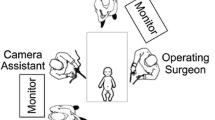Abstract
The aim of this study was to evaluate the clinical advantages of a single-stage correction of imperforate anus with a rectourethral or a rectovestibula fistula in neonates by a semi-posterior sagittal anorectoplasty (PSARP). The medical records of 38 neonates (5 females and 33 males) who had imperforate anus with a rectourethral or a rectovestibula fistula were reviewed and analyzed in Children’s Hospital of Fudan University between January 2004 and July 2007. All patients had an anorectal malformation but without obvious sacral dysplasia. The first group had a single-stage PSARP without a colostomy. All neonates were full-term without severe cardiac, renal anomalies or severe abdominal distension. The second group had a staged Peña procedure; the neonates were not suitable for a single-stage PSARP because of severe abdominal distention or cardiac, renal anomalies. A transverse colostomy was performed, followed 3–6 months later by the Peña procedure, and colostomy closure 2 months thereafter. The congenital anomalies, fetal age, birth weight, time and age of the definitive operation, complications, length of hospital stay, cost, and postoperative bowel movements were analyzed between these two groups. Among the 38 patients, 22 had a single-stage definitive operation and 16 had a staged pull-through procedure. There were significant differences in congenital anomalies between the two groups (P = 0.0314), but no statistically significant differences between the fetal ages, weight at birth, and time and age at the time of the definitive operation (P > 0.05). One patient in the first group had intestinal obstruction and intestinal perforation. For the second group, early complications were related to the colostomy. At after 3 years postoperatively, 9 patients in the first group and 12 patients in the second group were followed-up and all had positive voluntary bowel movements. There were no statistically significant differences in soiling and constipation grades between the two groups. The total length of hospital stay was 12.06 ± 0.85 and 33.85 ± 0.94 days and the cost was 10,681.1 ± 1,759.5 and 27,355.9 ± 1,952.0 RMB for the first and second groups, respectively. There was a statistically significant difference in the total length of hospital stay and cost between the two groups (P < 0.0001); however, there were no statistically significant differences in the length of hospital stay and cost during the definitive operation between the two groups (P > 0.05). This retrospective study shows that it is feasible for correction of imperforate anus with a rectourethral or a rectovestibula fistula in neonates using a modified PSARP without a colostomy.
Similar content being viewed by others
References
Albanese CT, Jennings RW, Lopoo JB, Bratton BJ, Harrison MR (1999) One-stage correction of high imperforate anus in the male neonate. J Pediatr Surg 34:834–836
Adeniran JO (2002) One-stage correction of imperforate anus and rectovestibular fistula in girls: preliminary results. J Pediatr Surg 37:16–19
Adeniran JO, Abdur-Rahman L (2005) One-stage correction of intermediate imperforate anus in males. Pediatr Surg Int 21:88–90
Goergeson KE, Inge TH, Albanese CT (2000) Laparoscopically assisted anorectal pull-through for high imperforate anus—a new technique. J Pediatr Surg 35:927–930
Iwanaka T, Arai M, Kawashima H, Kudou S, Fujishiro J, Matsui A, Imaizumi S (2003) Findings of pelvic musculature and efficacy of laparoscopic muscle stimulator in laparoscopy-assisted anorectal pull-through for high imperforate anus. Surg Endosc 17:278–281
Lima M, Tursini S, Ruggeri G, Aquino A, Gargano T, De Biagi L, Ahmed A, Gentili A (2006) Laparoscopically assisted anorectal pull-through for high imperforate anus: 3 years experience. J Laparoendosc Adv Surg Tech A 16:63–66
Chen CJ (1999) The treatment of imperforate anus: experience with 108 patients. J Pediatr Surg 34:1728–1732
Holschneider AM, Jesch NK, Stragholz E, Pfrommer W (2002) Surgical methods for anorectal malformation from Rebein to Peña. Critical assessment of score systems and proposal for a new classification. Eur J Pediatr Surg 12:73–83
Rintala RJ, Lindahl HG (1999) Posterior sagittal anorectoplasty is superior to sacroperineal-sacroabdominoperineal pullthrough: a long-term follow-up study in boys with high anomalies. J Pediatr Surg 34:334–337
Holschneider A, Huston J, Peña A, Bekhit E (2005) Preliminary report on the international conference for the development of standards for the treatment of anarectal malformations. J Pediatr Surg 40:1521–1526
Long L, Qizhi Y, Liumin H, Gang L, Lie Y, Jun J, Baofu L, Shuqing W, Ping W (2003) One-stage correction of high imperforate anus with laparoscopy-assisted anorectoplasty. Chin J Minim Invasive Surg 3:199–201
Long L, Jing-bo F, Qi-zhi Y, Liumin H, Gang L, Lie Y, Jun J, Baofu L, Shuqing W, Ping W (2004) Laparoscopy-assisted anorectoplasty for high imperforate anus. Chin J Pediatr Surg 25:420–422
Kudou S, Iwanaka T, Kawashima H, Uchida H, Nishi A, Yotsumoto K, Kaneko M (2005) Midterm follow-up study of high-type imperforate anus after laparoscopically assisted anorectoplasty. J Pediatr Surg 40:1923–1926
Iwanaka T, Uchida H, Kawashima H, Nishi A, Kudou S, Satake R (2004) Complications of laparoscopic surgery in neonates and small infants. J Pediatr Surg 39:1838–1841
Peña A, De Vries P (1982) Posterior sagittal anorectoplasty: important technical considerations and new applications. J Pediatr Surg 17:796–811
De Vries P, Peña A (1982) Posterior sagittal anorectoplasty. J Pediatr Surg 17:638–643
Peña A (1995) Anorectal malformation. Semin Pediatr Surg 4:35–47
Pakarinen MP, Baillie C, Koivusalo A, et al (2006) Transanal endoscopic-assisted proctoplasty—a novel surgical approach for individual management of patients with imperforate anus without fistula. J Pediatr Surg 41:314–317
Cahill JL, Christie DL (1985) Results after posterior sagittal anorectoplasty: a new approach to high imperforate anus. Am J Surg 149:629–631
Author information
Authors and Affiliations
Corresponding author
Rights and permissions
About this article
Cite this article
Zheng, S., Xiao, X. & Huang, Y. Single-stage correction of imperforate anus with a rectourethral or a rectovestibula fistula by semi-posterior sagittal anorectoplasty. Pediatr Surg Int 24, 671–676 (2008). https://doi.org/10.1007/s00383-008-2154-4
Accepted:
Published:
Issue Date:
DOI: https://doi.org/10.1007/s00383-008-2154-4




